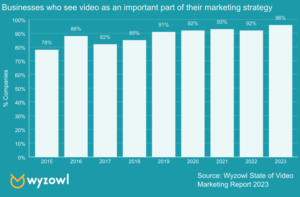
Video Marketing Trends in 2023
Video Marketing Trends in 2023
Are You Using Video in Your Marketing?
As we delve into 2023, the increasing importance of video marketing cannot be overstated. This medium has emerged as a crucial component in digital marketing strategies worldwide, transforming how businesses communicate with their audience and market their products or services.
This post will explore various facets of the evolving video marketing industry. From understanding the statistics that underscore its meteoric rise to evaluating ROI from video content, you’ll gain insights into why this tool is indispensable for your business.
We’ll also discuss how social media platforms like TikTok and YouTube shape consumer behavior through videos. The trend towards live videos and short-form content such as Instagram Reels and YouTube Shorts creates new opportunities for brands to connect with potential customers.
Moreover, you’ll learn about different types of long-form content, like webinars and explainer videos, that enhance viewer retention rates. Lastly, we will analyze engagement levels between pre-recorded vs LIVE formats while emphasizing quality over quantity in producing materials.
Looking for Digital Marketing for DIY small business owners? AskDotty gives you actionable strategies to grow your business.
The Rise of Video Marketing in the Business World
As we enter 2023, video marketing has become a must-have for businesses. According to Wyzowl’s State of Video Marketing Survey, 91% of businesses use videos in their marketing strategy and see positive returns on investment (ROI). This trend is only going to get bigger, despite the growing competition.

Statistics Backing the Rise of Video Marketing
Did you realize that when someone watches a video, they remember 95% of the content while just 10% is retained from reading it in the text? That’s not all – people spend over one-third of their online time watching videos daily. These numbers show the incredible power and reach of video marketing.
Understanding the ROI of Video Content
Here’s a fun fact: videos can reduce support calls by up to 41%. That means less time spent on customer service and more resources available for other areas. And if you want potential customers to understand your products or services better, product demos via videos are the way to go.
Take a cue from Hyundai’s collaboration with K-Pop group BTS. They used music and visuals to raise awareness about hydrogen and effectively promote their brand to diverse audiences worldwide. The result? A successful campaign that showcases the immense possibilities of powerful video marketing strategies.
Unsurprisingly, nearly all marketers agree that videos positively impact user understanding, enhancing brand awareness and driving higher engagement rates on social media platforms like YouTube Shorts and Instagram Reels. By investing in quality videos, marketers can ensure that their content effectively resonates with potential customers—a key factor for any successful digital marketing initiative. That’s the real power behind any successful digital marketing initiative today.
Key Takeaway:
Video marketing has become essential for businesses in 2023, with 91% of companies using videos and seeing positive returns on investment. Videos significantly impact user understanding, brand awareness, and engagement rates on social media platforms like YouTube Shorts and Instagram Reels.
The Impact of Social Media Platforms on Video Marketing
Social media sites are the trendsetters when it comes to video marketing. TikTok and YouTube are the popular kids who have changed the game and influenced how consumers behave.
Social media platforms have drastically transformed the landscape of video marketing.
Increased Reach: Social media platforms provide access to billions of users worldwide. According to data from 2023, Facebook had over 2.98 billion active users per month, YouTube had over 2.68 billion, and Instagram had over 2.35 billion. This vast audience base significantly increases the reach of video content.
Engagement: Videos on social media platforms generate more engagement than other content types. Users are likelier to share, like, or comment on video content, further amplifying its reach.
Stories and Live Streaming: Features like “Stories” on Instagram and Facebook and live streaming on platforms like YouTube, Twitch, TikTok, Instagram, and Facebook have created new ways for marketers to connect with their audience in real-time or with more ephemeral, authentic content.
E-commerce Integration: Social media platforms increasingly integrate shopping features into their platforms, enabling direct product promotion through video content. This means consumers can now purchase products directly from videos, enhancing the effectiveness of video marketing.
Demographics: Social media platforms collect user information, allowing marketers to target their video content to specific demographics, locations, and user interests. This increases the relevance of marketing messages to individual users, thereby increasing the effectiveness of marketing efforts.
Video Ads: Social media platforms offer video ads (like YouTube’s skippable and non-skippable or Instagram’s in-feed video ads), providing marketers with flexible and diverse options for promoting their products or services.
Viral Potential: Social media platforms can amplify the reach of video content exponentially if it goes viral. Viral videos can generate huge brand exposure at relatively low costs.
User-generated content: Social media platforms are the perfect stage for user-generated content, which can be a powerful marketing tool. Marketers can leverage user-generated video content for authentic testimonials or creative product uses.
Analytics: Social media platforms offer robust analytics that helps marketers understand what’s working and not in their video marketing strategy. They can measure views, engagement, conversion, reach, and more.
Keep in mind that while social media offers significant opportunities for video marketing, it also presents challenges. The content must stand out in crowded news feeds, stay relevant in an ever-changing digital landscape, and appeal to a diverse, global audience. Successful video marketing on social media requires a clear understanding of your target audience, a well-planned strategy, and regular performance analysis and adjustments.
TikTok and YouTube: Shaping Consumer Behavior, One Video at a Time
TikTok’s short-form videos have taken the world by storm, allowing businesses to create content that grabs attention. Meanwhile, YouTube is the go-to platform for longer videos, perfect for product demos and reviews.
A study by Influencer Marketing Hub found that people spend an average of 40 minutes per session watching videos on these platforms. Talk about captivated audiences.
If you hesitate to use TikTok because it is Chinese-owned, a similar platform called Clapper is US based.
Storytelling with Videos: The New Cool
In today’s fast-paced world, video storytelling is the way to go. It helps raise brand awareness and keeps audiences hooked.
Storytelling through videos is a powerful marketing technique that allows brands to connect with their audience on an emotional level. It helps humanize businesses and build more profound, lasting relationships with consumers.
Here are some ways to effectively tell stories with videos:
Define Your Message: The first step in creating a compelling video story is to define what message you want to convey. Your message could be about your brand’s mission, the value you provide, or a particular product or service you offer. Your message should be simple, clear, and relevant to your audience.
Understand Your Audience: The best stories resonate with the audience. Therefore, understanding your audience – their interests, challenges, and values – is critical. It enables you to create a story they can relate to and feel connected with.
Structure Your Story: A well-structured story can keep your audience engaged from start to finish. Generally, stories have a beginning (introduction or setup), middle (conflict or problem), and end (resolution). Introduce characters, present a challenge, and then show how that challenge is overcome.
Use Emotion: Stories that evoke emotions are more engaging and memorable. Whether it’s happiness, sadness, surprise, or inspiration, strive to make your audience feel something with your video story.
Show, Don’t Tell: Video is a visual medium, so make the most of it! Instead of telling your audience about a product’s features, show them in action. Instead of telling them about your values, show examples of them in your business.
Include a Clear Call-to-Action: After engaging your audience with a compelling story, direct them on what to do next. This could be visiting your website, purchasing a product, signing up for a newsletter, or any other action that aligns with your marketing goals.
Maintain Authenticity: Authentic stories can help build trust and loyalty. Be true to your brand and values. Authenticity can make your brand more relatable and your story more believable.
Leverage User-Generated Content: User-generated content can provide authentic and relatable stories about your brand or product. Encourage your audience to share their own stories related to your brand.
Remember, storytelling is not just about selling a product or service. It’s about sharing experiences, emotions, and values that resonate with your audience. A well-told story can leave a lasting impression and create a strong emotional connection between your audience and your brand.
Instagram Stories: Share daily updates and behind-the-scenes footage to give viewers a peek behind the curtain.
YouTube Shorts: Get your message across in just 60 seconds with quick snapshots of new products or company news.
Livestreams: Connect with your audience in real time through Q&A sessions or live product demos.
These video storytelling techniques keep viewers engaged and encourage them to share your content, spreading the word about your brand like wildfire. So, if you haven’t jumped on the video marketing bandwagon for 2023, now’s the time.
Video marketing is taking over social media platforms like TikTok and YouTube, shaping consumer behavior and captivating audiences. Don’t miss out on the trend in 2023.
LIVE Videos – An Emerging Trend
In the digital marketing landscape 2023, LIVE video content is quickly becoming a powerful video marketing tool. According to Influencer Marketing Hub, it’s projected that live videos will account for about 17 percent of all internet traffic in 2023. This trend is driven by expected spending of $184 billion over five years on this form of content.
Projections related to live videos
The increasing success of live videos is due to their capacity to provide direct, real-time engagement with audiences. Whether it’s Instagram reels or YouTube Shorts, businesses are finding success in reaching out directly to potential customers through these platforms.
Importance & benefits associated with real-time interaction
User Engagement: Live video allows users to interact directly with brands, increasing engagement rates significantly compared to pre-recorded materials.
Authenticity: The unedited nature of live streams adds a layer of authenticity that audiences appreciate and trust more than polished ads or product demos.
Trend-Setting Capabilities: Brands can use this format to raise awareness about new products or initiatives immediately after they launch, setting trends rather than following them.
This shift towards interactive content has led marketers to agree that incorporating LIVE video into their strategy has positively impacted brand awareness and customer retention. Studies show that viewers retain 95% of a message when delivered via video compared to just 10% for text-based communication. This makes watching videos enjoyable and highly effective from a business perspective.
Key Takeaway:
Live videos are becoming increasingly important in digital marketing, with projections showing that they will account for 17% of internet traffic by next year. This trend is driven by the ability of live videos to offer real-time interaction with viewers, increasing user engagement and authenticity while allowing brands to set trends and raise awareness about new products or initiatives immediately after launch.
Short-form Videos – The Hilarious Secret to Marketing Success
COVID-19 has forced us to go digital, and guess what? Short-form videos are all the rage. Platforms like Instagram Reels, YouTube Shorts, and TikTok are where the cool kids hang out, and businesses are cashing in on the fun.
Get Ready to Go Viral.
Short-form videos can explode like fireworks. They can reach millions quickly, boosting your brand and getting people talking. Plus, they’re a hit with all age groups, so everyone from Gen Z to Boomers will be dancing to your tune. According to Influencer Marketing Hub, 90% of consumers say product videos help them make buying decisions. Cha-ching.
Laugh Your Way to Success
Here’s the secret ingredient: humor. Funny videos are like a magnet for viewers. They’re entertaining, relatable, and oh-so-shareable on social media. Forbes says humor in advertising boosts recall by 26%. Why not tick their funny bone if you aim to make a splash?
So, what are you waiting for? Jump on the short-form video bandwagon and watch your business soar. Just remember, quality beats quantity every time. Get those creative juices flowing and start making hilarious videos that’ll have everyone hitting that share button.
Boost your brand and make buying decisions easier with hilarious short-form videos. Join the video marketing trend and watch your business soar.
Long-form Content Types – Enhancing Retention Rates
Long-form content such as webinars and fireside chats effectively maintains viewers’ attention in digital marketing. These in-depth discussions and insightful conversations pack a punch, delivering messages with maximum impact.
Webinars and Fireside Chats: Keeping Viewers Hooked
Webinars, lasting an hour or more, provide valuable information on specific topics, while fireside chats create a relaxed atmosphere for industry leaders to share their experiences. Both formats encourage active participation, leading to higher engagement and better retention rates.
A study by the Influencer Marketing Hub revealed that people watch LIVE videos 10-20 times longer than pre-recorded ones. Talk about keeping potential customers glued to their screens.
Explainer Videos: Converting Viewers into Customers
Now, let’s dive into explainer videos – the short animated wonders that are taking the video marketing industry by storm. These captivating videos use clear language and attractive visuals to explain business ideas engagingly.
A recent survey conducted by Wyzowl found that landing pages featuring explainer videos have higher conversion rates than those without. 95% of users reported that watching an explainer video helped them understand a product better, leading to more confident purchasing decisions.
Video marketing is booming in 2023. Long-form content like webinars and fireside chats keep viewers hooked, while explainer videos convert them into customers.
Pre-recorded VS LIVE Formats – Analyzing Engagement Levels
In video marketing, pre-recorded and live formats have their charm. But pre-recorded videos often give a better return on investment. Let’s see why brands should focus on creating quality pre-recorded content.
Difference between Pre-recorded vs LIVE Format in Terms of Engagement Levels
The choice between pre-recorded and live formats affects engagement. Live videos offer real-time interaction, but they can be unpredictable. Unlike live unpredictable videos, pre-recorded videos can be tailored to provide a polished end product that resonates with viewers.
A study by Influencer Marketing Hub reveals that viewers retain 95% of a message when watching it in a video, compared to just 10% when reading it in text form. That’s the power of well-crafted video content.
Benefits of Focusing on Quality Over Quantity When Producing Pre-Recorded Materials
Focusing on quality has its merits when producing pre-recorded materials. High-grade material is more likely to be propagated across digital media outlets, leading to greater visibility and reach for a brand.
Better Control: With pre-recording, you control every aspect, ensuring top-notch content reaches your audience.
Reusability: Pre-recorded videos can be reused across different platforms, maximizing exposure. They are often evergreen – have no expiration date.
Ease Of Scheduling: YouTube Shorts or Instagram Reels can be scheduled ahead, providing flexibility while maintaining consistency in your digital marketing strategy.
Discover the power of pre-recorded videos in digital marketing. With better control, reusability, and scheduling options, they’re a game-changer for brands.
The Increasing Importance of Video Marketing in 2023
Video marketing is not going anywhere in 2023 unless it is up. Viewers retain 95% of a message when delivered through video content, so it’s time to get your camera rolling.
Social media platforms like TikTok and YouTube have turned us all into video watchers, so you better start making videos if you want to reach your audience. Plus, live and short-form videos are all the rage, offering real-time interaction and viral potential.
Long-form content like webinars and explainer videos are also worth investing in, as they keep viewers engaged and increase your chances of converting them into customers. Quality over quantity, my friends.
Want more ideas to grow your business? Join the AskDotty membership today!


